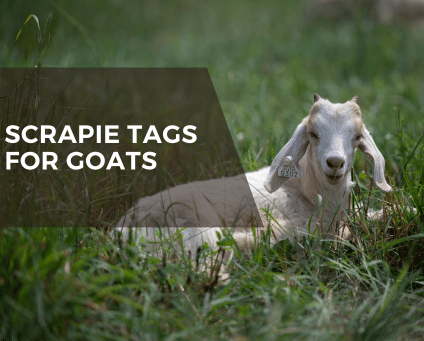This blog is meant as a general overview of scrapie tags for goats. For updated information specific to your state’s individual regulations, please consult with your local agriculture office and/or the USDA.
One important facet of making a business out of raising meat goats is ensuring that your operation abides by certain USDA regulations. This includes making sure that each animal has a form of official identification in the form of an ear tag that shows their place of birth should there be a diagnosis of scrapie in order to prevent a larger outbreak.
Table of contents
What is scrapie in goats?
Scrapie is a fatal disease that affects the central nervous system of goats and sheep and is classified as a transmissible spongiform encephalopathy (TSE).
Symptoms can take months to develop and generally include a lack of coordination, the inability to get up from a lying down position and behavioral changes.
The method of transmission is still being studied but typically goats are infected as young kids and stay infected their entire lives. It also sheds quickly through feces, saliva and urine which means the rest of the herd (or other herds they come into contact with) can be infected quickly.
Scrapie has no current treatment and can only be concretely diagnosed after the death of the animal.
Source: Merck Veterinary Manual, USDA
Scrapie tag for goats – requirements
An official scrapie ear tag is required to be inserted in an ear of any show goats, goats over 18 months of age, and intact male goats under 18 months not moving into slaughter channels prior to leaving the farm where they were born.
To sell live animals, as opposed to just the meat, records of each animal along with their scrapie tag number must be kept and easily retrieved. Full details of record keeping requirements can be found in this USDA factsheet.
Source: Premier 1, USDA
What happens if there’s an outbreak?
If scrapie is detected in one of your goats the USDA will work with you and a vet to remove all exposed and genetically susceptible goats, do testing on the rest of the herd and help consult on breeding for genetic resistance. Kidding facilities will need to be carefully cleaned and disinfected and an improved management plan of animals at kidding time will also need to be developed.
Source: USDA
What’s included in the scrapie tags?
Scrapie tags include the number of the individual goat, your farm’s identification name or number, your official scrapie herd number and the USDA’s official seal.
How to get scrapie tags for your goats
Before ordering your scrapie tags you first need to obtain a farm ID number. You can do this through your local FSA office where they will ask for your personal identification as well as your farm business identity and proof of control of the land. You will then be issued a number.
Scrapie tags cannot be handwritten or handmade and must be ordered from an approved manufacturer, including Allflex USA, Alliance ID and Premier 1. The full list can be found on the USDA website.
How to put in a goat ear tag
Goat ear tags are inserted using an applicator. Tags need to be no more than two inches away from the head (to avoid more tearable tissue areas) and as close to the center of the ear as possible, avoiding the large vein in the ear.
Make sure the two “halves” of the ear tag are positioned on either end of the applicator with the male tag on the back side of the ear. Ensure that the ear is between the jaws of the applicator, grip the ear firmly and completely close the applicator until the tag is fully inserted in the ear.
Alternatives to scrapie tags
Instead of a scrapie tag, tattoos are also an option, provided that you can provide proof of identification for the goat within the herd either in the form of paperwork or as an additional tattoo. You will be responsible for ensuring that tattoos are legible. EID microchips are another option though you will be required to have your farm and/or herd identification on hand as well. Scrapie tags do have some advantages in that they’re easy to visually spot and read and can help with record keeping and tracking of overall animal health.
Be sure to check with your local and/or a state veterinarian to verify that whatever identification process you decide to use is approved.
References
- USDA APHIS Scrapie Program. “Sheep and Goat Identification”
- Merck Veterinary Manual. “Scrapie”
- Premier 1. “Ear Tags for USDA Scrapie Eradication Program”

LEAVE A COMMENT
Comments